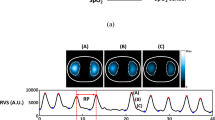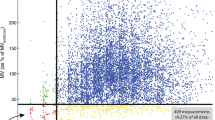Abstract
Capnography involves the measurement of end-tidal CO2 (EtCO2) values to detect hypoventilation in patients undergoing sedation. In a previous study, we reported that initiating a flexible bronchoscopy (FB) examination only after detecting signs of hypoventilation could reduce the risk of hypoxemia without compromising the tolerance of the patient for this type of intervention. We hypothesize that hypoventilation status could be determined with greater precision by combining thoracic impedance-based respiratory signals, RESP, and EtCO2 signals obtained from a nasal-oral cannula. Retrospective analysis was conducted on RESP and EtCO2 waveforms obtained from patients during the induction of sedation using propofol for bronchoscopic examination in a previous study. EtCO2 waveforms associated with hypoventilation were then compared with RESP patterns, patient variables, and sedation outcomes. Signals suitable for analysis were obtained from 44 subjects, 42 of whom presented indications of hypoventilation, as determined by EtCO2 waveforms. Two subtypes of hypoventilation were identified by RESP: central-predominant (n = 22, flat line RESP pattern) and non-central-predominant (n = 20, RESP pattern indicative of respiratory effort with upper airway collapse). Compared to cases of non-central-predominant hypoventilation, those presenting central-predominant hypoventilation during induction were associated with a lower propofol dose (40.2 ± 18.3 vs. 60.8 ± 26.1 mg, p = 0.009), a lower effect site concentration of propofol (2.02 ± 0.33 vs. 2.38 ± 0.44 µg/ml, p = 0.01), more rapid induction (146.1 ± 105.5 vs. 260.9 ± 156.2 s, p = 0.01), and lower total propofol dosage (96.6 ± 41.7 vs. 130.6 ± 53.4 mg, p = 0.04). Hypoventilation status (as revealed by EtCO2 levels) could be further classified by RESP into central-predominant or non-central-predominant types. It appears that patients with central-predominant hypoventilation are more sensitive to propofol during the induction of sedation. RESP values could be used to tailor sedation management specifically to individual patients.




Similar content being viewed by others
References
Gaisl T, Bratton DJ, Heuss LT, Kohler M, Schlatzer C, Zalunardo MP, Frey M, Franzen D. Sedation during bronchoscopy: data from a nationwide sedation and monitoring survey. BMC Pulm Med. 2016;16(1):113. https://doi.org/10.1186/s12890-016-0275-4.
Jose RJ, Shaefi S, Navani N. Sedation for flexible bronchoscopy: current and emerging evidence. Eur Respir Rev. 2013;22(128):106–16. https://doi.org/10.1183/09059180.00006412.
Wahidi MM, Jain P, Jantz M, Lee P, Mackensen GB, Barbour SY, Lamb C, Silvestri GA. American College of Chest Physicians consensus statement on the use of topical anesthesia, analgesia, and sedation during flexible bronchoscopy in adult patients. Chest. 2011;140(5):1342–50. https://doi.org/10.1378/chest.10-3361.
Sheahan CG, Mathews DM. Monitoring and delivery of sedation. Br J Anaesth. 2014;113(Suppl 2):ii37–47. https://doi.org/10.1093/bja/aeu378.
Hinkelbein J, Lamperti M, Akeson J, Santos J, Costa J, De Robertis E, Longrois D, Novak-Jankovic V, Petrini F, Struys M, Veyckemans F, Fuchs-Buder T, Fitzgerald R. European Society of Anaesthesiology and European Board of Anaesthesiology guidelines for procedural sedation and analgesia in adults. Eur J Anaesthesiol. 2018;35(1):6–24. https://doi.org/10.1097/EJA.0000000000000683.
Force ASoAT. Practice guidelines for sedation and analgesia by non-anesthesiologists. Anesthesiology. 2002;96(4):1004–17.
Lo YL, Lin TY, Fang YF, Wang TY, Chen HC, Chou CL, Chung FT, Kuo CH, Feng PH, Liu CY, Kuo HP. Feasibility of bispectral index-guided propofol infusion for flexible bronchoscopy sedation: a randomized controlled trial. PLoS ONE. 2011;6(11):e27769. https://doi.org/10.1371/journal.pone.0027769.
Lin TY, Lo YL, Hsieh CH, Ni YL, Wang TY, Lin HC, Wang CH, Yu CT, Kuo HP. The potential regimen of target-controlled infusion of propofol in flexible bronchoscopy sedation: a randomized controlled trial. PLoS ONE. 2013;8(4):e62744. https://doi.org/10.1371/journal.pone.0062744.
Clark G, Licker M, Younossian AB, Soccal PM, Frey JG, Rochat T, Diaper J, Bridevaux PO, Tschopp JM. Titrated sedation with propofol or midazolam for flexible bronchoscopy: a randomised trial. Eur Respir J. 2009;34(6):1277–83. https://doi.org/10.1183/09031936.00142108.
Worsnop C, Kay A, Pierce R, Kim Y, Trinder J. Activity of respiratory pump and upper airway muscles during sleep onset. J Appl Physiol. 1998;85(3):908–20.
Brown EN, Lydic R, Schiff ND. General anesthesia, sleep, and coma. N Engl J Med. 2010;363(27):2638–50. https://doi.org/10.1056/NEJMra0808281.
Lo YL, Ni YL, Wang TY, Lin TY, Li HY, White DP, Lin JR, Kuo HP. Bispectral index in evaluating effects of sedation depth on drug-induced sleep endoscopy. J Clin Sleep Med. 2015;11(9):1011–20. https://doi.org/10.5664/jcsm.5016.
Eastwood PR, Platt PR, Shepherd K, Maddison K, Hillman DR. Collapsibility of the upper airway at different concentrations of propofol anesthesia. Anesthesiology. 2005;103(3):470–7.
Lin T-Y, Fang Y-F, Huang S-H, Wang T-Y, Kuo C-H, Wu H-T, Kuo H-P, Lo Y-L. Capnography monitoring the hypoventilation during the induction of bronchoscopic sedation: a randomized controlled trial. Sci Rep. 2017;7(1):8685. https://doi.org/10.1038/s41598-017-09082-8.
Task Force of the European Society of Cardiology and the North American Society of Pacing and Electrophysiology. (1996) Heart rate variability: standards of measurement, physiological interpretation and clinical use. Circulation. 93(5):1043–1065.
Daubechies I, Lu J, Wu H-T. Synchrosqueezed wavelet transforms: an empirical mode decomposition-like tool. Appl Comput Harmonic Anal. 2011;30(2):243–61. https://doi.org/10.1016/j.acha.2010.08.002.
Tang Y, Turner MJ, Baker AB. Effects of lung time constant, gas analyser delay and rise time on measurements of respiratory dead-space. Physiol Meas. 2005;26(6):1103–14. https://doi.org/10.1088/0967-3334/26/6/019.
Proctor DN, Beck KC. Delay time adjustments to minimize errors in breath-by-breath measurement of Vo2 during exercise. J Appl Physiol (1985). 1996;81(6):2495–9. https://doi.org/10.1152/jappl.1996.81.6.2495.
Lichtenbelt BJ, Mertens M, Vuyk J. Strategies to optimise propofol-opioid anaesthesia. Clin Pharmacokinet. 2004;43(9):577–93.
Lysakowski C, Dumont L, Pellegrini M, Clergue F, Tassonyi E. Effects of fentanyl, alfentanil, remifentanil and sufentanil on loss of consciousness and bispectral index during propofol induction of anaesthesia. Br J Anaesth. 2001;86(4):523–7.
Mertens MJ, Olofsen E, Burm AG, Bovill JG, Vuyk J. Mixed-effects modeling of the influence of alfentanil on propofol pharmacokinetics. Anesthesiology. 2004;100(4):795–805.
Murphy M, Bruno MA, Riedner BA, Boveroux P, Noirhomme Q, Landsness EC, Brichant JF, Phillips C, Massimini M, Laureys S, Tononi G, Boly M. Propofol anesthesia and sleep: a high-density EEG study. Sleep. 2011;34(3):283–91A.
Hillman DR, Walsh JH, Maddison KJ, Platt PR, Kirkness JP, Noffsinger WJ, Eastwood PR. Evolution of changes in upper airway collapsibility during slow induction of anesthesia with propofol. Anesthesiology. 2009;111(1):63–71. https://doi.org/10.1097/ALN.0b013e3181a7ec68.
Dahan A, Teppema LJ. Influence of anaesthesia and analgesia on the control of breathing. Br J Anaesth. 2003;91(1):40–9.
Krauss B, Hess DR. Capnography for procedural sedation and analgesia in the emergency department. Ann Emerg Med. 2007;50(2):172–81. https://doi.org/10.1016/j.annemergmed.2006.10.016.
Nagler J, Krauss B. Capnography: a valuable tool for airway management. Emerg Med Clin N Am. 2008;26(4):881–97. https://doi.org/10.1016/j.emc.2008.08.005.
Kodali BS. Capnography outside the operating rooms. Anesthesiology. 2013;118(1):192–201. https://doi.org/10.1097/ALN.0b013e318278c8b6.
Iohom G, Ni Chonghaile M, O’Brien JK, Cunningham AJ, Fitzgerald DF, Shields DC. An investigation of potential genetic determinants of propofol requirements and recovery from anaesthesia. Eur J Anaesthesiol. 2007;24(11):912–9. https://doi.org/10.1017/S0265021507000476.
Mikstacki A, Zakerska-Banaszak O, Skrzypczak-Zielinska M, Tamowicz B, Prendecki M, Dorszewska J, Molinska-Glura M, Waszak M, Slomski R. The effect of UGT1A9, CYP2B6 and CYP2C9 genes polymorphism on individual differences in propofol pharmacokinetics among Polish patients undergoing general anaesthesia. J Appl Genet. 2017;58(2):213–20. https://doi.org/10.1007/s13353-016-0373-2.
Taylor MB, Grounds RM, Mulrooney PD, Morgan M. Ventilatory effects of propofol during induction of anaesthesia. Comparison with thiopentone. Anaesthesia. 1986;41(8):816–20.
Bailey PL, Streisand JB, East KA, East TD, Isern S, Hansen TW, Posthuma EF, Rozendaal FW, Pace NL, Stanley TH. Differences in magnitude and duration of opioid-induced respiratory depression and analgesia with fentanyl and sufentanil. Anesth Analg. 1990;70(1):8–15.
Wilkinson JN, Thanawala VU. Thoracic impedance monitoring of respiratory rate during sedation—is it safe? Anaesthesia. 2009;64(4):455–6. https://doi.org/10.1111/j.1365-2044.2009.05908.x.
Acknowledgements
This study was supported by Chang-Gung Memorial Hospital (Grant No. CMRPG3E2241).
Author information
Authors and Affiliations
Corresponding author
Ethics declarations
Conflict of interest
We declare no conflicts of interest.
Additional information
Publisher's Note
Springer Nature remains neutral with regard to jurisdictional claims in published maps and institutional affiliations.
Rights and permissions
About this article
Cite this article
Lo, YL., Wu, HT., Lin, YT. et al. Hypoventilation patterns during bronchoscopic sedation and their clinical relevance based on capnographic and respiratory impedance analysis. J Clin Monit Comput 34, 171–179 (2020). https://doi.org/10.1007/s10877-019-00269-0
Received:
Accepted:
Published:
Issue Date:
DOI: https://doi.org/10.1007/s10877-019-00269-0




